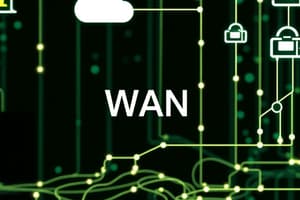Podcast
Questions and Answers
What is the primary characteristic of a Metropolitan Area Network (MAN)?
What is the primary characteristic of a Metropolitan Area Network (MAN)?
- Links computers over a vast geographic area.
- Links computers within a group of buildings. (correct)
- Connects computers within a single building.
- Utilizes exclusively fiber-optic cables.
Which components are fundamental for the functionality of a network?
Which components are fundamental for the functionality of a network?
- Routers, switches, and physical media. (correct)
- Cables, apps, and virtualization.
- Firewalls, gateways, and data packets.
- Modems, servers, and wireless networks.
What is meant by network architecture?
What is meant by network architecture?
- The overall design structured in layers for functionality. (correct)
- The cost associated with setting up a network.
- The protocols used exclusively for data transmission.
- The physical layout of cable connections in a network.
What is a significant benefit of using a Local Area Network (LAN)?
What is a significant benefit of using a Local Area Network (LAN)?
Which of the following best describes 'protocols' in networking?
Which of the following best describes 'protocols' in networking?
What type of media is commonly used to connect computers in a Local Area Network (LAN)?
What type of media is commonly used to connect computers in a Local Area Network (LAN)?
How do switches contribute to the functionality of a network?
How do switches contribute to the functionality of a network?
In what context is the term 'nodes' used in networking?
In what context is the term 'nodes' used in networking?
What is an example of a Wide Area Network (WAN)?
What is an example of a Wide Area Network (WAN)?
What enables users to share schedules and communications in a networked environment?
What enables users to share schedules and communications in a networked environment?
Which topology allows for the highest resilience to a cable break?
Which topology allows for the highest resilience to a cable break?
What is the primary advantage of using a ring topology?
What is the primary advantage of using a ring topology?
Which cable type is primarily associated with bus topology?
Which cable type is primarily associated with bus topology?
What characteristic describes how data is transmitted in a star topology?
What characteristic describes how data is transmitted in a star topology?
Which of the following is NOT a common network topology?
Which of the following is NOT a common network topology?
Which component is used with Category 5 cable in a star topology?
Which component is used with Category 5 cable in a star topology?
What does a home page represent within the structure of a website?
What does a home page represent within the structure of a website?
What distinguishes a web page from a website?
What distinguishes a web page from a website?
Which aspect of network topology primarily affects the installation complexity?
Which aspect of network topology primarily affects the installation complexity?
Which of the following is a notable characteristic of star topology concerning cost?
Which of the following is a notable characteristic of star topology concerning cost?
Which statement about topologies in LAN is accurate?
Which statement about topologies in LAN is accurate?
What is a primary function of a Point of Presence (POP) in a WAN?
What is a primary function of a Point of Presence (POP) in a WAN?
Which of the following media does NOT typically connect to a Point of Presence?
Which of the following media does NOT typically connect to a Point of Presence?
Which of these is not a typical bandwidth measurement unit mentioned?
Which of these is not a typical bandwidth measurement unit mentioned?
What aspect of a WAN is best defined by the term 'bandwidth'?
What aspect of a WAN is best defined by the term 'bandwidth'?
How does a token in a ring topology help in network communication?
How does a token in a ring topology help in network communication?
Which statement describes a significant drawback of adding new workstations in a ring topology?
Which statement describes a significant drawback of adding new workstations in a ring topology?
What is the impact of using ADSL as a connection medium?
What is the impact of using ADSL as a connection medium?
Which type of network transmission speed qualifies as broadband?
Which type of network transmission speed qualifies as broadband?
What is a key characteristic of peer-to-peer networks?
What is a key characteristic of peer-to-peer networks?
Which type of wiring media transmits data as light impulses?
Which type of wiring media transmits data as light impulses?
In a client-server network, what is the role of the server?
In a client-server network, what is the role of the server?
Which network topology involves a centralized server and multiple client nodes?
Which network topology involves a centralized server and multiple client nodes?
What is a disadvantage of peer-to-peer networks compared to client-server networks?
What is a disadvantage of peer-to-peer networks compared to client-server networks?
Which type of media is commonly used in home networking for its simplicity and cost-effectiveness?
Which type of media is commonly used in home networking for its simplicity and cost-effectiveness?
Which of the following statements is true regarding network operating systems (NOS)?
Which of the following statements is true regarding network operating systems (NOS)?
Which wireless transmission method uses a transmitter and receiver system?
Which wireless transmission method uses a transmitter and receiver system?
Which type of network configuration would be considered least effective for sharing large files across many users?
Which type of network configuration would be considered least effective for sharing large files across many users?
What is the primary role of network interface cards (NICs) in a LAN?
What is the primary role of network interface cards (NICs) in a LAN?
Flashcards
Local Area Network (LAN)
Local Area Network (LAN)
A network that links computers within a building or close proximity, using cables, radio waves, or infrared signals.
Metropolitan Area Network (MAN)
Metropolitan Area Network (MAN)
A network that connects computers within a group of buildings, usually within a city or metropolitan area, using fiber-optic cables.
Wide Area Network (WAN)
Wide Area Network (WAN)
A network that connects computers over long distances, spanning cities, states, or even countries, using long-distance transmission media.
Networking Synergies
Networking Synergies
Signup and view all the flashcards
Physical Media Used in Networks
Physical Media Used in Networks
Signup and view all the flashcards
Routers
Routers
Signup and view all the flashcards
Switches
Switches
Signup and view all the flashcards
Protocols
Protocols
Signup and view all the flashcards
Network Architecture
Network Architecture
Signup and view all the flashcards
Protocol Stack
Protocol Stack
Signup and view all the flashcards
Peer-to-peer LAN
Peer-to-peer LAN
Signup and view all the flashcards
Client-server LAN
Client-server LAN
Signup and view all the flashcards
Network Interface Card (NIC)
Network Interface Card (NIC)
Signup and view all the flashcards
Network Operating System (NOS)
Network Operating System (NOS)
Signup and view all the flashcards
LAN Topology
LAN Topology
Signup and view all the flashcards
Twisted Pair Cable
Twisted Pair Cable
Signup and view all the flashcards
Coaxial Cable
Coaxial Cable
Signup and view all the flashcards
Fiber-Optic Cable
Fiber-Optic Cable
Signup and view all the flashcards
Infrared (IR)
Infrared (IR)
Signup and view all the flashcards
Radio
Radio
Signup and view all the flashcards
Star Topology
Star Topology
Signup and view all the flashcards
Bus topology
Bus topology
Signup and view all the flashcards
Ring Topology
Ring Topology
Signup and view all the flashcards
Point Of Presence (POP)
Point Of Presence (POP)
Signup and view all the flashcards
Bandwidth
Bandwidth
Signup and view all the flashcards
Broadband
Broadband
Signup and view all the flashcards
Permanent Virtual Circuit (PVC)
Permanent Virtual Circuit (PVC)
Signup and view all the flashcards
56 Kbps Leased Line
56 Kbps Leased Line
Signup and view all the flashcards
Integrated Services Digital Network (ISDN)
Integrated Services Digital Network (ISDN)
Signup and view all the flashcards
Asymmetric Digital Subscriber Line (ADSL)
Asymmetric Digital Subscriber Line (ADSL)
Signup and view all the flashcards
Network Topology
Network Topology
Signup and view all the flashcards
Node
Node
Signup and view all the flashcards
Internet
Internet
Signup and view all the flashcards
HTML
HTML
Signup and view all the flashcards
Web Page
Web Page
Signup and view all the flashcards
Web Site
Web Site
Signup and view all the flashcards
Home Page
Home Page
Signup and view all the flashcards
Study Notes
Computer Networks and Internet
- Computer networks connect computers and devices.
- Networks are categorized by their size.
- LAN (Local Area Network): Connects computers in a building or close proximity. Uses direct cables, radio, and infrared.
- WAN (Wide Area Network): Connects computers over larger distances, potentially thousands of miles. Utilizes long-distance transmission media.
- MAN (Metropolitan Area Network): Connects computers within a city or group of buildings. Commonly uses fiber-optic cable.
- CAN (Campus Area Network): A type of LAN connecting buildings on a campus.
- HAN (Home Area Network): A small network for devices in a home.
Networking Synergies
- Sharing hardware reduces costs and resources.
- Shared applications like software enable users to share resources and programs.
- Groupware facilitates communication and scheduling.
- Using network resources to share data is efficient.
Network Fundamentals
- Physical media: Cables (telephone lines, coaxial), microwaves, satellites, wireless, and fiber optic transmit network signals. They connect computers.
- Routers: Examine transmitted data and direct it to the proper destination.
- Switches: High-speed electronic devices that maintain connections between computers.
- Protocols: Standards dictating how network components communicate.
Network Architecture
- Network architecture is the overall design of a network.
- Layers separate functions and tasks.
- A protocol stack vertically arranges the layers, managed by own set of protocols.
Local Area Networks (LANs)
- LANs interconnect computers and peripherals within a building.
- LANs enable software, data, and peripherals access.
- LANs involve special hardware and software.
- Stations or nodes make up the computing components connected to a LAN.
- Peer-to-peer: All computers are equal with no dedicated file server.
- Client-server: Servers manage and store data; clients access data.
LAN Hardware and Software
- Hardware: Network interface cards (NICs) are computer expansion cards.
- Software: Operating system (like Unix, Linux, Windows, Mac OS) for network operations, with additional specialized software.
Peer-to-Peer Networks
- All computers are equal; no dedicated file server.
- Users decide which files and peripherals to share.
- Easy setup, but not suitable for large networks.
Client-Server Networks
- Employ various topologies (physical layouts).
- Networked computers (clients) and a network operating system (NOS).
- Clients request services (programs, data, or access to peripherals) from servers.
Network Media
- Twisted pair: Two insulated wires, commonly used in telephones.
- Coaxial cable: Insulated wire with braided outer wire, similar to cable TV.
- Fiber-optic cable: Glass fiber cables that send data as light impulses, capable of extended distances and high speeds.
- Infrared: Wireless technology using infrared signals to transmit data.
- Radio: Wireless data transmission using radio signals.
Types of Telephone Transmission Media
- Twisted pair copper wire: Used for telephone transmission.
- Fiber optics: Used for transmitting data as light impulses.
- Satellites: Used for transmitting data through satellites in space.
- Microwave: Used for sending data on microwave signals.
Internet History
- A timeline of key internet development including packet switching, ARPANET, TCP/IP, WWW, and commercial internet.
Local Area Network Diagram
- Diagram illustrating a simple LAN with PCs, a Router, server and printer.
Internet Diagram
- Diagram showing the flow of internet traffic from a home network through a router, to an internet service provider then the internet backbone ending at the domain services.
Web protocols-HTTP
- HTTP defines how webpages are transferred or transmitted.
- Web servers deliver web pages.
Web page tags and descriptions
- HTML tags describe the page structure and content, like headings, paragraphs, images, and hyperlinks. They control the format and appearance of the page.
HTML Document with example code
- Example HTML code demonstrating the basic structure of an HTML document.
Web Page Design
- Hypertext Markup Language (HTML) describes the structure of web pages and content displays.
Web Site
- A collection of related web pages.
- Index/Home page is the main page.
Web Page
- A single page of information, including links to other pages.
Home Page
- The main or first page of a website.
- Default starting page when the web browser launches or opens.
Link
- Words/images displayed to take the user to another web page.
Text Box
- A box where a single line of text can be entered.
Text Area
- A box used to input multiple lines of text.
Drop-down Box
- Displays list of options from which to choose (usually for selections).
Back
- Allows the user to revisit the previously viewed web page.
Most Popular Web Browsers (1995 - 2023)
- Graphical representation showing the popularity of different web browsers.
Search Engine
- A website that searches the internet for specific information.
Uniform Resource Locator (URL)
- Website or web resource address.
File Transfer Protocol (FTP)
- Transmitting files between computers, sometimes done anonymously.
- FTP Servers host these files and their collections.
Studying That Suits You
Use AI to generate personalized quizzes and flashcards to suit your learning preferences.



